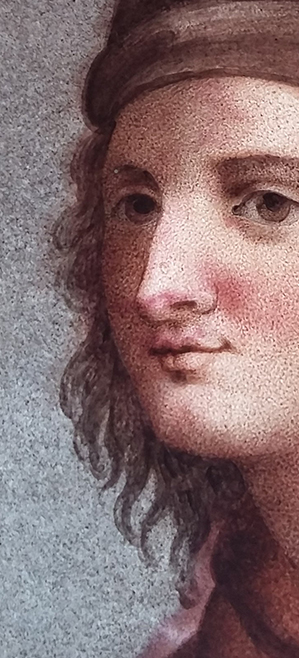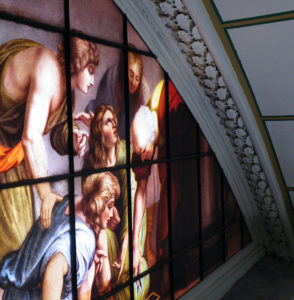
Stourhead House Library, Warminster: National Trust
Architectural
Stourhead House, Stourton, Warminster, Wiltshire.
Library lunette, by Francis Eginton
The repair of an early 19th century painted lunette, by Francis Eginton at Stourhead Library.
Built in 1725 Stourhead, Wiltshire, is a grand Palladian style country villa, within celebrated landscaped grounds. Today it is owned by the National Trust. In the south elevation of the library at Stourhead is a large lunette It is a highly decorative and richly coloured masterpiece, made in 1803 by English glass painter Francis Eginton (1737-1805). The subject matter is a rendering of an original fresco by Raphael – the ‘School of Athens’ from the Apostolic Palace of the Vatican City. It is composed of one large central section and two smaller outer sections. Each section is constructed in a grid with rectangles of crown glass held together in a rigid structure with brass glazing bars.
The glass has been treated in Eginton’s unique technique which gives a great depth of colour and texture, and involving painting on all four faces of two panes, which are placed together in each rectangle of the brass frame. It is signed and dated in the lower left pane of the central section ‘Frs. Eginton 1803’.
Eginton was influenced by Matthew Boulton’s Soho factory in Birmingham, where he was a supervisor in the japanning section. Critically Eginton collaborated with Boulton on a method of printing images onto glass. The methods employed for the engraved plates for Boulton’s polygraphs or ‘sun pictures’ fed directly into Eginton’s working methods. Eginton set up his own studio in the 1780’s and formulated the method of layering painted and enamelled crown glass, like that visible in the Stourhead lunette. He carried out other large scale commissions, notably at St. Paul’s Church Birmingham, and at St. Alkmund, Shrewsbury. His painted works are like transparencies on glass, where the glass is treated like a painted canvas.
At Stourhead, Eginton’s customary practice of having protective glazing outside the fragile enamelled glass is evident. Problems with cracking of the thin panes of glass are common, due to the glass being glazed tight against the metal frame, set into very hard linseed oil putty.
Treatment of the window initially involved the removal of debris from the interspace. The conservation approach was to presume in favour of retention in-situ, unless in a parlous condition and after close assessment for stability 13 individual glass panes were removed from the frame and taken to the workshop for conservation treatment. Those with cracks in them were edge-bonded. The remainder was lightly cleaned in-situ. Any old repairs were not disturbed unless found to be unstable. The repaired panes were re-installed on-site by dry mounting them into the frames, fixing only on the external corners with conservation grade silicone adhesive.
Click here to see more of this project:-
http://www.holywellglass.com/work/stourhead-library/
Click here to see another project by Francis Eginton:-
http://www.holywellglass.com/work/st-alkmunds/






